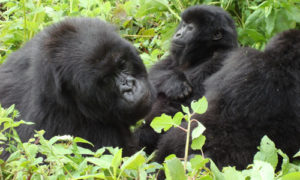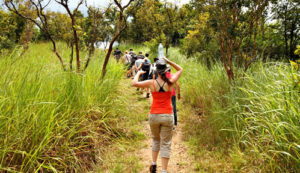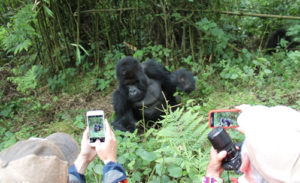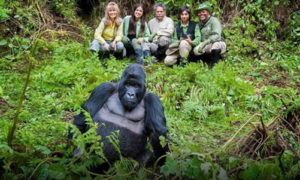About Rwanda Rwanda is a unitary republic in central and eastern Africa. Uganda is to its north, Tanzania to the east, Burundi to the south, and the Democratic Republic of Congo to the west. While the country is landlocked, it is noted for its lakes. Despite being close to the equator, the climate is temperate due to the altitude. The highest point is Mount Karisimbi. Tourism is important due to wildlife, including the mountain gorilla. Kigali, Gitarama, and Butare are the largest cities. Since the end of the Rwandan Genocide, the country has been socially and politically stable. As a result, agriculture, roads, mining, and tourism have developed. There are still a large number of people that live in poverty. The president, Paul Kagame, and his party, the RPF, firmly hold power in the country. History Humans migrated to what is now Rwanda after the last ice age. Hunter gatherers settled the area in the late Stone Age and were followed by early Iron Age settlers. These were ancestors of the Twa, a group of Pygmy hunters who still remain in Rwanda. Additional migrations took place between 700 BC and 1500 AD. This divided society into three groups which are the Hutu, Tutsis, and the original Twas. There are several theories regarding the origins of these groups. Oral history indicates the Kingdom of Rwanda was founded on Lake Muhazi’s shore in the 14th or 15th centuries. By playing its larger neighbors against each other, the kingdom flourished and expanded. The Banyoro invaded in the late 16th or 17th century, which forced the kings west. In the 17th century, a new dynasty was formed by King Ruganzu Ndori. The conquest of Bugesera began the Rwandan kingdom’s dominance of the area. The kingdom extended into modern day DRC and Uganda at its
 About Rwanda
About Rwanda
Rwanda is a unitary republic in central and eastern Africa. Uganda is to its north, Tanzania to the east, Burundi to the south, and the Democratic Republic of Congo to the west. While the country is landlocked, it is noted for its lakes. Despite being close to the equator, the climate is temperate due to the altitude. The highest point is Mount Karisimbi. Tourism is important due to wildlife, including the mountain gorilla. Kigali, Gitarama, and Butare are the largest cities.
Since the end of the Rwandan Genocide, the country has been socially and politically stable. As a result, agriculture, roads, mining, and tourism have developed. There are still a large number of people that live in poverty. The president, Paul Kagame, and his party, the RPF, firmly hold power in the country.
History
Humans migrated to what is now Rwanda after the last ice age. Hunter gatherers settled the area in the late Stone Age and were followed by early Iron Age settlers. These were ancestors of the Twa, a group of Pygmy hunters who still remain in Rwanda. Additional migrations took place between 700 BC and 1500 AD. This divided society into three groups which are the Hutu, Tutsis, and the original Twas. There are several theories regarding the origins of these groups.
Oral history indicates the Kingdom of Rwanda was founded on Lake Muhazi’s shore in the 14th or 15th centuries. By playing its larger neighbors against each other, the kingdom flourished and expanded. The Banyoro invaded in the late 16th or 17th century, which forced the kings west. In the 17th century, a new dynasty was formed by King Ruganzu Ndori. The conquest of Bugesera began the Rwandan kingdom’s dominance of the area. The kingdom extended into modern day DRC and Uganda at its peak.
In 1884, the Berlin Conference assigned Germany Ruanda-Urundi. German East Africa was then formed when this area was combined with Tanganyika. In 1894, Gustav Adolf von Gotzen explored the country. The Germans did not alter the country’s social structure, but supported the king. The Germans did favor the Tutsi group and help suppress Hutu rebellions. During World War I, the Belgians took the territory.
After World War I, Rwanda became a League of Nations mandate with Belgium in control. As opposed to the German approach, Belgium was more involved in the territory, including health, public works, education, and agriculture. Belgians attempted to improve agriculture, but this did not prevent major famines from occurring. Belgium also kept the class system in place and promoted Tutsi supremacy. They also considered the groups to be different races and created identity cards labeling each person a member of the Tutsi, Hutu, or Twa group. They based this classification on arbitrary physical characteristics. If there was a borderline case, those with ten or more cattle owned were labeled Tutsi, with the rest labeled Hutu.
After World War II, Belgium controlled Rwanda as a U.N. Trust Territory. Two groups emerged and became rivals, one based on the Tutsi elite and the other based on Hutu emancipation. Around this time the Belgians stopped supporting the hierarchy and favored the Hutu party. Tensions escalated and between 1959 and 1961, Hutus killed hundreds of Tutsis and caused over 100,000 to flee the country. The first elections were held in 1962 along with a referendum to abolish the monarchy. In 1962, Rwanda separated from Burundi and gained independence under Hutu leader Gregoire Kayibanda. Violence continued with exiled Tutsis attacking from neighboring countries and Hutus retaliating within Rwanda. A military coup in 1973 led to Juvenal Habyarimana becoming president. During the coup, Kayibanda and his wife were killed, along with several other high ranking figures. The following years were relatively prosperous and violence largely subsided. Pro-Hutu discrimination continued.
The Rwandan Civil War began in 1990 when the Rwandan Patriotic Front (RPF), a group of mostly Tutsi refugees, invaded from Uganda. The government, with French support, suppressed the RPF. A stalemate had occurred by 1992. The two sides agreed to a cease fire in 1993 despite continued ethnic strife.
On April 6, 1994, the cease fire ended when Habyarimana’s plane was brought down near the Kigali Airport, killing the president and his Burundian counterpart. The responsible side is still unknown. This was a spark that started the Rwandan Genocide. Over 100 days, 500,000 to 1,000,000 Tutsis and moderate Hutus were killed. The attacks were well planned and done on the interim government’s orders, led by Theoneste Bagosora. The RPF restarted their offensive, which resulted in their taking control of the country. There was limited international response and the major powers did not want to expand the overstretched U.N. peacekeeping force. The French eventually sent in troops to create a safe area, but this did not happen soon enough. The RPF took the capital on July 4 and the entire country on July 18, 1994. Pasteur Bizimungu was sworn in as the interim president.
Two million Hutus had fled to neighboring countries due to fears of RPF reprisals. Epidemics killed thousands in the refugee camps. In 1996, problems in Zaire forced most refugees to return to Rwanda. These tensions and attacks by interahamwe militia from neighboring countries led Rwanda to become involved in the First and Second Congo Wars.
An International Criminal Tribunal for Rwanda (ICTR) began a period of reconciliation and justice. During the 2000s, the flag, constitution, and anthem were changed and local authority boundaries were re-drawn. The economy and tourism grew during the time as well.
Politics and Government
Rwanda is a presidential republic with multiple political parties. In 2003, the current constitution was adopted. The president, who is elected to serve a seven year term, is the head of state and has broad powers. The current president is Paul Kagame, who won elections in 2003 and 2010.
There is little corruption in Rwanda. There is an Ombudsman set forth in the constitution who has the duty of fighting corruption. The economy has grown quickly and infrastructure is improving. There has been some criticism of the government for suppressing dissent.
There are two chambers of Parliament. The Chamber of Deputies has 80 seats whose members serve five year terms. 24 seats are reserved for women and three are reserved for disabled and youth members. The remaining seats are selected by universal suffrage. In 2008, female members made up a majority, the first time in Africa this occurred. The Senate has 26 seats and whose members serve terms of eight years. A variety of bodies select the Senators.
German and Belgian civil law systems are the basis for Rwanda’s legal structure. There is an independent judiciary, but the Senate and President are involved in the court appointments. The constitution sets out ordinary and specialized courts. Specialized courts are military courts and those for trials of genocide suspects. The ordinary courts are the Supreme Court, the High Court, and regional courts.
Since 1994, the RPF has dominated politics. While it is seen as a Tutsi-dominated party, it receives wide support and credit for the country’s stability.
Rwanda belongs to La Francophonie, but English has gained more use than French. In 2009, the country joined the Commonwealth of Nations. Rwanda is also a member of the East African Community. Rwanda has a tense relationship with the Democratic Republic of Congo because Rwanda was involved in the First and Second Congo Wars.
Administrative Divisions
Rwanda’s current constitution divides the country into provinces, districts, cities, municipalities, towns, sectors, and cells. Parliament establishes these boundaries. A governor heads each province and is appointed by the president with Senate approval.
Geography and Climate
Rwanda’s area is 26,338 sq. km and is located in central and east Africa. The Congo and Nile River drainage basins run north to south. The Nyabarongo is the longest river, which meets up with the Kagera and drains into Lake Victoria. Lake Kivo is the largest of many lakes in Rwanda. It is one of the 20 deepest world lakes with a depth of 480 meters.
Central and western Rwanda is mountainous. The Virunga Mountains are the highest peaks and includes Mount Karisimbo, the country’s highest peak at 4,507 meters. The western part of Rwanda has a 1,500 meter to 2,500 meter average elevation.
Due to the high altitude, Rwanda has lower temperatures than those typically found near the equator. There are two rainy seasons with the first running from February to June and the second from September to December. There is generally twice as much rainfall in the west as opposed to the east.
Economy and Infrastructure
The genocide impacted the economy and caused a large drop in GDP. Rwanda’s economy has strengthened with per capita GDP’s increasing significantly since the genocide. The U.S., China, and Germany are major export markets. The National bank of Rwanda manages the economy and the currency is the Rwandan franc.
Rwanda does not have abundant natural resources. Semi-subsistence farming is the basis of the economy. While Rwanda is fertile, production of food does not keep pace with population growth.
Coffee, tea, bananas, pyrethrum, beans, sorghum, and potatoes are grown in Rwanda. Coffee and tea are the main cash crops. Livestock are also raised and this contributes to 8.8 percent of GDP. Epidemics and poor feed quality hurt this industry.
There is a small industrial sector that manufactures cement, beverages, soap, furniture, shoes, cigarettes, and textiles. While there are few natural resources, mining is still important. Minerals include wolframite, gold, coltan, and cassiterite.
Tourism is growing quickly and is now a leading earner of foreign exchanges. Rwanda is perceived as a safe destination despite the genocide. In Volcanoes National Park, tourists participate in tracking the mountain gorillas.
Most Rwandans have radios and televisions are mostly found in urban areas. The largest television and radio stations are run by the state. The press has restrictions and often self-censor.
There has been an increase in transport infrastructure since the genocide. There are paved roads between the capital and other major cities. Roads also link Rwanda to neighboring countries. The Share taxi is the primary mode of transportation for the public. Kigali has an international airport, but there are no railways.
Demographics
Rwanda’s population was estimated at over 12,3 million, with over 42 percent under the age of 15. The infant mortality rate is 59.59 deaths for every 1,000 live births. Life expectancy is 59.26 years.
Rwanda has one of Africa’s highest population densities. Most of the population is rural. The savanna land in the east is the only area that is sparsely populated. Kigali’s population is approximately one million. An influx of people into Kigali is straining infrastructure.
Most of the people in Rwanda practice Christianity. Catholics were 56.5 percent of the population in 2006 and Protestants were 37.1 percent. Muslims were 4.6 percent of the people.
Kinyarwanda is the principal language spoken by most of the people. French was introduced during colonialism, but English has been introduced by refugees from Uganda and other nations. English, French, and Kinyarwanda are all official languages. Swahili is spoken by many in rural areas.
Culture
Rwanda has been a unified state since before colonialism with one main ethnic group, the Banyarwanda, and a shared language. There are eleven regular holidays including Genocide Memorial Day on April 7.
Music and dance are also important in ceremonies. The most well-known dance is Intore, which has three components, a ballet, a dance of heroes, and the drums. Drums are very important and royal drummers have always had high status.
Rwandan cuisine is based on staple foods like bananas, plantains, sweet potatoes, pulses, beans, and cassava. Any Rwandans only eat meat a few times per month.
The country also has a history of traditional arts and crafts, especially woven bowls and baskets. Cow dung art is noted in south east Rwanda.
There is not a long history of written literature, but a strong oral tradition exists. Many of the moral values and histories are passed down orally through the generations. Alexis Kagame is the most famous literary figure.
Education
There is free education for nine years in Rwanda. There are plans to extend free education for the additional three years. The requirement to purchase books and uniforms prevents many rural children from attending school. There are many higher education establishments, including the Kigali Institute of Science and Technology, the Kigali Institute of Education, and the National University of Rwanda.

 Clothing: When deciding on the clothes to pack for gorilla trekking, ensure you include water proof trousers, jackets, long sleeved shirts, sweaters, long socks and long trousers. The right clothing will help protect you from getting wet, sharp tree branches, the sun and insects/ants. Always tack in your trousers to your boots to prevent safari ants and other insects from entering your body. Other clothing to take into consideration while planning your gorilla tour are a pair of shorts for relaxation while back at the lodge and Pajamas for the cold nights. Also include long socks to cover your feet.
Clothing: When deciding on the clothes to pack for gorilla trekking, ensure you include water proof trousers, jackets, long sleeved shirts, sweaters, long socks and long trousers. The right clothing will help protect you from getting wet, sharp tree branches, the sun and insects/ants. Always tack in your trousers to your boots to prevent safari ants and other insects from entering your body. Other clothing to take into consideration while planning your gorilla tour are a pair of shorts for relaxation while back at the lodge and Pajamas for the cold nights. Also include long socks to cover your feet. Gloves: Garden gloves will help you hold trees, branches and other vegetation. The gloves will also protect your hands from scratches and insect bites. As we already noted earlier, the forest can get muddy and slippery. The gloves will help you hold tree branches when climbing or the ground in case you slide. Gloves are a must in any packing list for gorilla trekking.
Gloves: Garden gloves will help you hold trees, branches and other vegetation. The gloves will also protect your hands from scratches and insect bites. As we already noted earlier, the forest can get muddy and slippery. The gloves will help you hold tree branches when climbing or the ground in case you slide. Gloves are a must in any packing list for gorilla trekking. Snacks, Packed lunch and drinking water: Gorilla trekking is very unpredictable. It all depends on the location of the
Snacks, Packed lunch and drinking water: Gorilla trekking is very unpredictable. It all depends on the location of the  Porters: Porters were briefly mentioned early and I will go into more details here. Porter help tourist carry any extra luggage or heavy cameras during gorilla trekking. They can also give you a helping hand when navigating through steep hills and valleys. Porter can help carry the elderly using special pouches when required. Porters charge a fee of about $15 and are normally residents of the surrounding areas. By paying for their services, you help the community, their families and make them desist from poaching. Some of the porters are students who are looking for fees to go back to school. We advise all our clients to hire a porter if they are not sure of their fitness level or if it has been determined that the gorilla family moves a lot.
Porters: Porters were briefly mentioned early and I will go into more details here. Porter help tourist carry any extra luggage or heavy cameras during gorilla trekking. They can also give you a helping hand when navigating through steep hills and valleys. Porter can help carry the elderly using special pouches when required. Porters charge a fee of about $15 and are normally residents of the surrounding areas. By paying for their services, you help the community, their families and make them desist from poaching. Some of the porters are students who are looking for fees to go back to school. We advise all our clients to hire a porter if they are not sure of their fitness level or if it has been determined that the gorilla family moves a lot. Think you know
Think you know  About Rwanda
About Rwanda United Nations World Tourism Organisation (UNWTO)’s theme for 2017 is sustainable tourism, a subject not so new in Rwanda. The country’s conservation journey began more than a decade ago and has since progressed enormously.
United Nations World Tourism Organisation (UNWTO)’s theme for 2017 is sustainable tourism, a subject not so new in Rwanda. The country’s conservation journey began more than a decade ago and has since progressed enormously. We’re often asked ‘when is the best time to go to Rwanda?’, and the answer is usually complex. It will depend on many things including your interests, where you want to visit and why you’re travelling. One person’s best time is another’s worst!
We’re often asked ‘when is the best time to go to Rwanda?’, and the answer is usually complex. It will depend on many things including your interests, where you want to visit and why you’re travelling. One person’s best time is another’s worst! Rwanda is a country of dramatic landscapes Credit: This content is subject to copyright./ullstein bild
Rwanda is a country of dramatic landscapes Credit: This content is subject to copyright./ullstein bild It’s been a long time since i updated this article and a lot has changed in Kigali’s late night scene since way back in 2010. Bars have closed (no more
It’s been a long time since i updated this article and a lot has changed in Kigali’s late night scene since way back in 2010. Bars have closed (no more